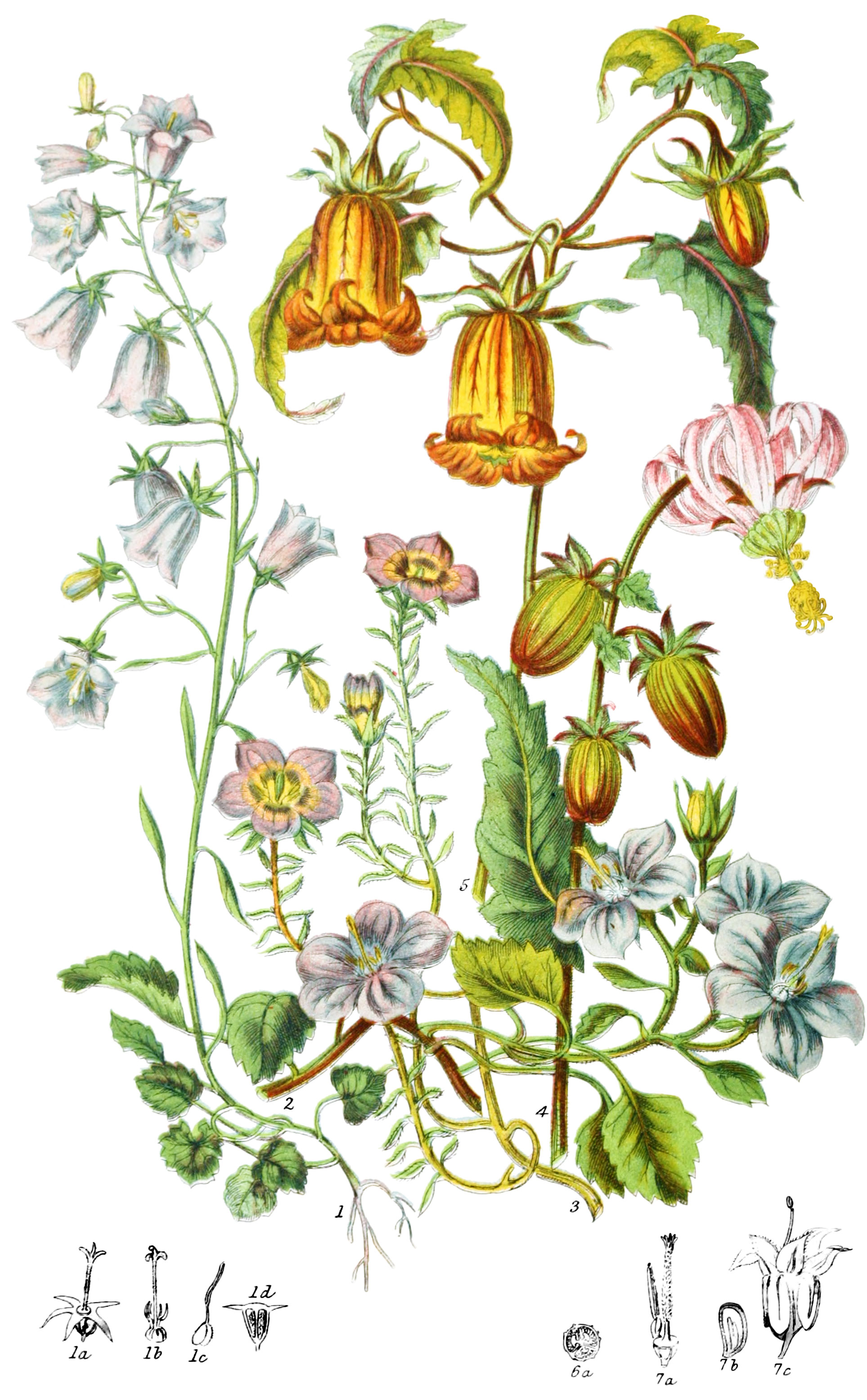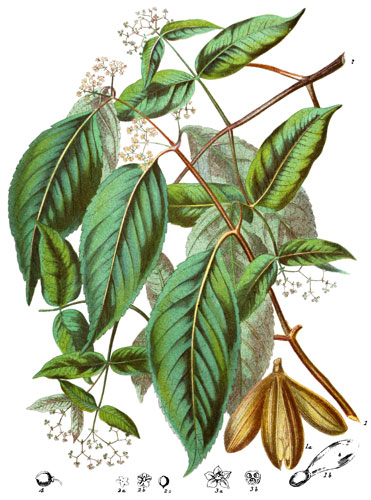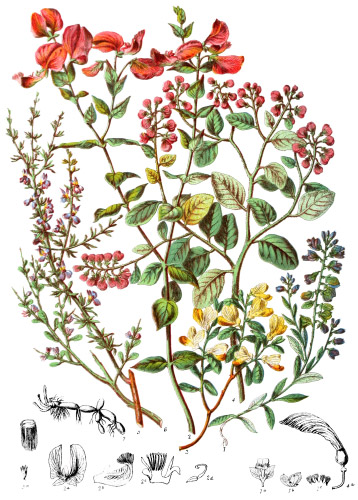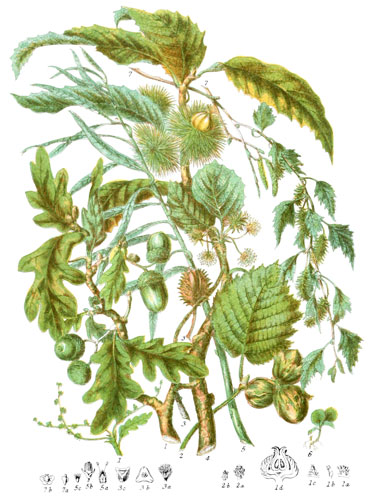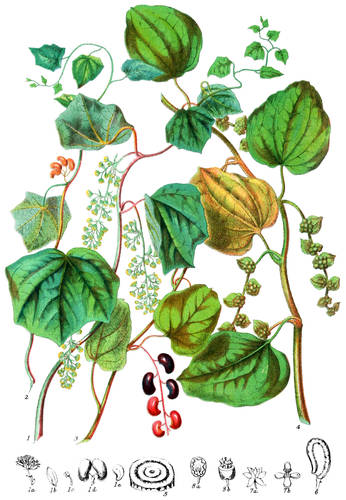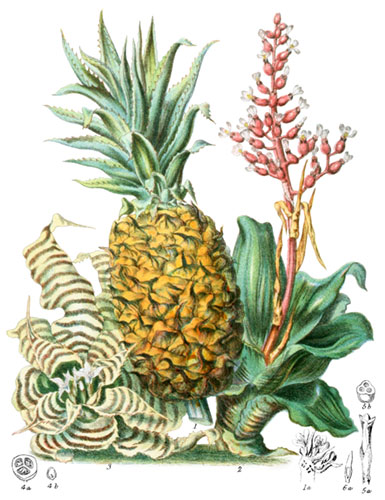Key characteristics
Herbaceous plants, and under-shrubs, containing a white milky juice. The leaves are almost always alternate, simple or divided, without stipules. The flowers are single, on branching stalks, in spikes or panicles, or in close heads, usually blue or white, rarely yellow. The calyx is above the ovary, usually five-lobed, remaining over the seed-vessel. The corolla is of one petal, inserted into the top of the calyx regular, generally five-lobed, withering on the seed-vessel. The stamens are inserted into the calyx alternately with the lobes of the corolla, to which they are equal in number. The anthers are two-celled, distinct. The ovary is below the calyx, with two or more cells, containing many seeds. The style is simple, clothed with hairs, which collect the pollen of the anthers; the stigma is simple, or with as many lobes as there are cells in the ovary. The seed-vessel is dry, crowned by the withered calyx and corolla, gaping when ripe by apertures at the base or side, or by valves at the top. The seeds are numerous, attached to a plate in the centre; they contain fleshy albumen.
This Order is closely allied to Lobeliaceæ, differing chiefly in the regularity of the parts of the flower: the Compositaceæ also it has much affinity.
An acrid milky juice prevails in these plants, but the roots of some are wholesome.
Select plants in this order
Not all plants listed are illustrated and not all plants illustrated are listed.
- Campanula, which gives the name to the tribe, was so called from the resemblance of the flower to a little bell; it contains several species gracefully elegant in form, of pure transparent hue, and delicate textures. Our British portion of the genus adds considerably to the floral beauty of the country, wherever the soil and climate may be favourable; in the month of July, the abundance of C. rotundifolia (1) is a striking embellishment of the scene in the meadows of the valley, and on the rocks of the [mountains throughout]* the Lake district of Westmoreland and Cumberland. It is very frequent in Scotland; the leaves are round only at the base, gradually becoming linear on the stem.
- C. latifolia, the giant bell-flower, is almost limited to the northern counties.
- C. Rapunculus Rampion was formerly cultivated for the sake of its white, sweet, pungent roots.
- Another species, with an eatable root, is C. lilifolia, which affords food to the Chinese.
- The root of C. glauca is considered a valuable tonic by the Japanese.
- C. medium, of Germany, was brought to English gardens about 250 years ago, named Canterbury bells, and has remained a favourite ever since. The calyx has appendages which hang down between the lobes (7).†
- C. pyramidalis, a native of Carniola, is a well-known ornament for halls, and in the mild temperature of Devonshire it continues to unfold its flowers on the tall spike till late in autumn, in the open air. In Holland, it is very generally trained to form a kind of screen before a window.
- Although blue is the prevailing colour of this genus, indeed of the whole tribe, yet there is one yellow-flowered species, C. aurea, in Madeira.
- Specularia is now made a separate genus; Venus’s looking-glass, with its white or bright purple flowr, is commonly to be seen in old-fashioned gardens.
- Wahlenbergia is an example of the capsules opening at the top: W. hederacea is a very delicate, trailing little plant, with pale flowers and ivy-shaped leaves, growing in boggy places in Wales and elsewhere; some larger species in hotter countries are used medicinally.
- Roella ciliata (3), named after a Dutch botanist, is one of several species from the Cape of Good Hope.
- Michauxia (4) displays a singular variety in the revolute petals, giving almost the aspect of a passion-flower; it was introduced from the Levant in 1787, but is now seldom to be seen, although deserving of more favour with gardeners than it receives, for it is recorded to grow to the height of six feet with many branches and abundant flowers.
- Canarina Campanula (5) was an early importation from the Canaries, and producing its six-lobed yellow and red flowers late in the season is a pleasing addition to the conservatory; the root is said to be eatable. This is one of the 310 flowering plants peculiar to the Canaries; the remaining 223 belong likewise to Africa.
- Phyteuma, an ancient Greek name, is now applied to a genus usually inhabiting lofty situations; P. orbiculare is found on our chalk downs; several others belong to the Swiss Alps, forming part of the close turf of the higher pastures.
- The roots of P. spicatum are eatable, and frequently used as a vegetable in Switzerland.
- Jasione montana, sheep’s-scabious, is very common on dry sandy ground, or heaths, as in Tunbridge Wells.
- Cyphia is a native of the Cape of Good Hope; one species is a climbing plant, another yields an eatable tuberous root to the Hottentots.
- Glossocomia is a connecting link with the Nightshade tribe.
- Codonopsis is a native of Cashmere and the Himalayas; Codonopsis rotundifolia has a climbing stem, which is not common in this tribe; the calyx and corolla are both occasionally six-lobed, which allies it to Canarina.
Locations
This tribe is abundant in Europe, and in North America; in the hot regions it is rarely seen; on the Alps and Appennines, on the Caucasus and the Altai mountains between 36° and 47° of N. latitude, the greater portion exists. At the Cape of Good Hope is another central locality for those genera chiefly whose capsules open at the top. Some remarkable species belong to the Canaries, S. Helena, and Juan Fernandez.
Legend
- Campanula rotundifolia, Round-leaved Blue-bell. Britain.
- Calyx and Pistil.
- Stamens and Pistil.
- Stamen.
- Section of Ovary.
- Campanula garganica, Mount St. Angelo Campanula. M. St. Angelo.
- Roella ciliata, Ciliated Roella. Cape of Good Hope.
- Michauxia campanuloides, Rough-leaved Michauxia. Levant.
- Canarina Campanula, Canary Bell-flower. Canaries.
-
- Section of Ovary of Campanula bononienis.
-
- Stamen and Pistil of Campanula medium.
- Section of Seed.
- Calyx, with Appendages.
- *“mountains throughout” was spelled as “mountain sthroughout” in the original description.
- †7 was mentioned in the original description but only 7a–7c were displayed in the illustration.
Explore more
Posters
Decorate your walls with colorful detailed posters based on Elizabeth Twining’s beautiful two-volume set from 1868.
Puzzles
Challenge yourself or someone else to assemble a puzzle of all 160 botanical illustrations.
